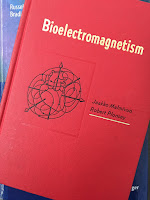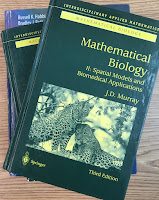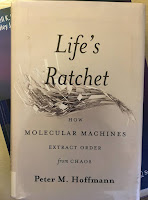 |
| The Eighth Day of Creation: The Makers of the Revolution in Biology, by Horace Freeland Judson. |
Hershey and Chase decided to see if they could strip off the empty phage ghosts from the bacteria and find out what they were and where their contents had gone. DNA contains no sulphur; phage protein has no phosphorus. Accordingly, they began by growing phage in a bacterial culture with a radioactive isotope as the only phosphorus in the soup [P32], which was taken up in all the phosphate groups as the DNA of the phage progeny was assembled, or, in the parallel experiment, by growing phage whose coat protein was labelled with hot sulphur [S35]. They used the phage to infect fresh bacteria in broths that were not radioactive, and a few minutes after infection tried to separate the bacteria from the emptied phage coats. “We tried various grinding arrangements, with results that weren’t very encouraging,” Hershey wrote later. Then they made a technological breakthrough, in the best Delbruck fashion of homely improvisation. “When Margaret McDonald loaned us her blender the experiment promptly succeeded.”This ordinary kitchen blender provided just the right shear forces to strip the empty bacteriophage coats off the bacteria. When tested, those bacteria infected by phages containing radioactive phosphorus were themselves radioactive, but those infected by phages containing radioactive sulphur were not. Thus, the DNA and not the protein is the genetic material responsible for infection. This was truly an elegant experiment. They key was the use of radioactive tracers. Russ Hobbie and I discuss nuclear physics and nuclear medicine in Chapter 17 of the 4th edition of Intermediate Physics for Medicine and Biology. We focus on medical applications of radioactive isotopes, but we should remember that these tracers also have played a crucial role in experiments in basic biology.
Hershey and Chase’s experiment, often called the Warring Blender experiment, is a classic studied in introductory biology classes. It was the high point of Chase’s career. She obtained her bachelor’s degree from the College of Wooster and was then hired by Hershey to work in his Cold Spring Harbor laboratory. She stayed at Cold Spring Harbor only three years, but in that time she and Hershey performed their famous experiment. In 1964 she obtained her PhD from the University of Southern California. Unfortunately, things did not go so well from Chase after that. Writer Milly Dawson tells the story.
In the late 1950s in California, she had met and married a fellow scientist, Richard Epstein, but they soon divorced… Chase suffered several other personal setbacks, including a job loss, in the late 1960s, a period that saw the end of her scientific career. Later, she experienced decades of dementia, with long-term but no short-term memory. [Waclow] Szybalski [a colleague at Cold Spring Harbor Laboratory in the 1950s] remembered his friend as “a remarkable but tragic person.”A good description of the Hershey-Chase experiment can be found here. You can learn more about life of Martha Chase in obituaries here and here. Szybalski’s reminiscences are recording in a Cold Spring Harbor oral history available here. Dawson’s tribute can be found here. And most importantly, the 1952 Hershey-Chase paper can be found here.








